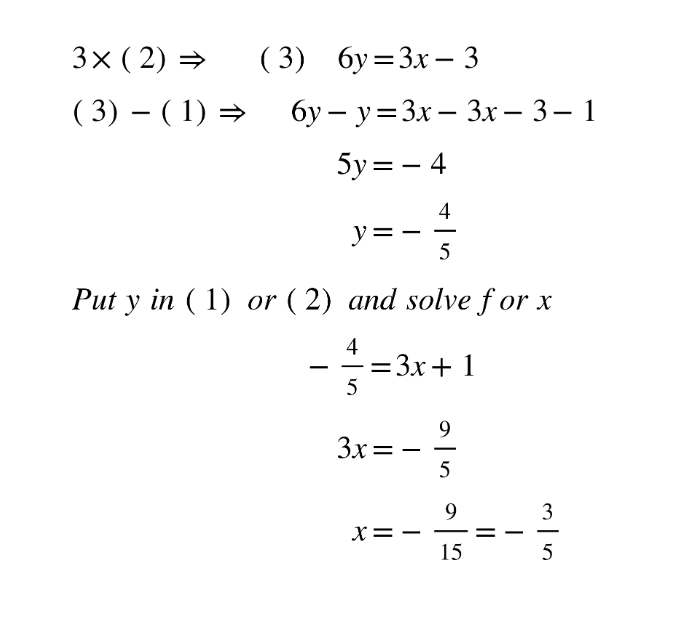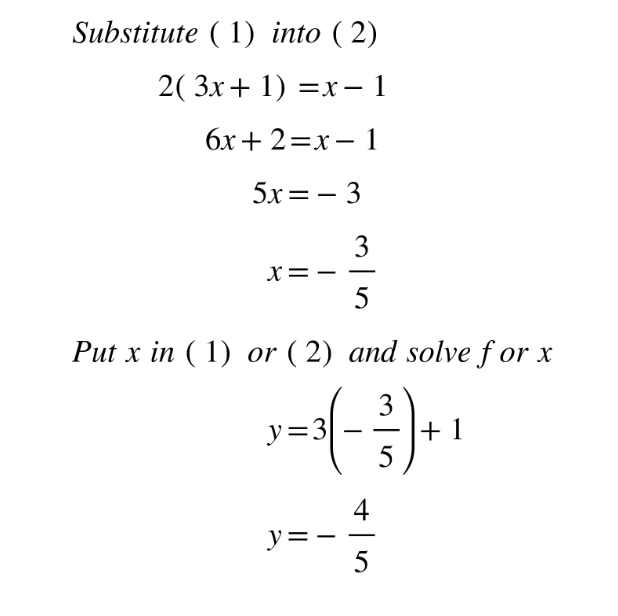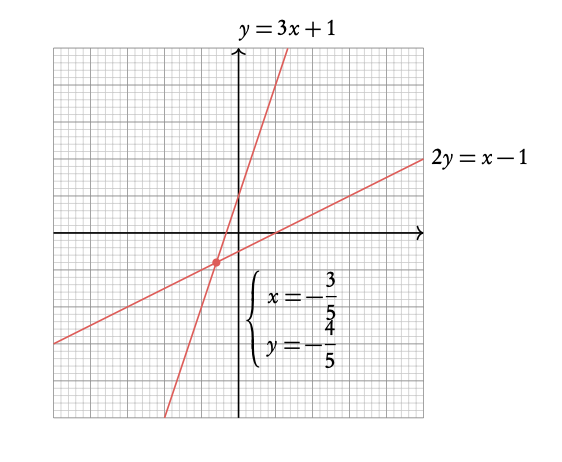If we have two unknowns, for example x and y, and two equations, then we can solve for x and y simultaneously.

There are 3 methods to solve simultaneous equations.
Elimination
Multiply an equation and then subtract it from the other in order to eliminate one of the unknowns.

Substitution
Rearrange and then substitute one in to another.

Graph
Graph both lines on your GDC. Where they intersect will be the solution to the equation.
Note that this method is also great when you have to solve more complex equations.

Solving Simultaneous Equations:
1. Introduction to Simultaneous Equations
Simultaneous equations, also known as systems of equations, consist of two or more equations with multiple variables. The goal is to find the values of the variables that satisfy all given equations simultaneously. These systems can be linear or non-linear, but this guide focuses primarily on linear simultaneous equations.
Example of a System of Two Linear Equations:
\[ \begin{cases} 2x + 3y = 8 \\ x - y = 1 \end{cases} \]
2. Types of Simultaneous Equations
a. Linear Systems
-
Two Variables: Involves two equations with two variables.
\[ \begin{cases} ax + by = c \\ dx + ey = f \end{cases} \]
-
Three Variables: Involves three equations with three variables.
\[ \begin{cases} ax + by + cz = d \\ ex + fy + gz = h \\ ix + jy + kz = l \end{cases} \]
b. Non-Linear Systems
Includes equations where at least one equation is non-linear (e.g., quadratic, exponential).
Note: This guide primarily addresses linear systems due to their widespread applicability and foundational importance.
3. Methods to Solve Simultaneous Equations
There are several methods to solve simultaneous equations. The choice of method often depends on the specific system and personal preference.
1. Substitution Method
Steps:
- Solve one equation for one variable.
- Substitute this expression into the other equation(s).
- Solve for the remaining variable.
- Back-substitute to find the other variable(s).
Advantages:
- Simple and straightforward for systems where one equation is already solved for a variable.
- Effective for small systems (two or three variables).
2. Elimination Method
Steps:
- Align the equations vertically with like terms in columns.
- Multiply one or both equations by constants to make the coefficients of one variable opposites.
- Add or subtract the equations to eliminate one variable.
- Solve for the remaining variable.
- Back-substitute to find the other variable(s).
Advantages:
- Efficient for larger systems.
- Avoids dealing with fractions as much as possible.
3. Graphical Method
Steps:
- Rewrite each equation in slope-intercept form (\( y = mx + c \)).
- Plot the lines represented by each equation on a graph.
- Identify the point(s) where the lines intersect. This point represents the solution.
Advantages:
- Provides a visual understanding of the solution.
- Useful for identifying the nature of the solution (unique, infinite, or none).
Limitations:
- Less precise, especially when dealing with non-integer solutions.
- Not practical for systems with more than three variables.
4. Matrix Method (Using Inverse Matrices or Gaussian Elimination)
Steps:
- Represent the system of equations in matrix form (\( AX = B \)).
- Find the inverse of matrix \( A \) (if it exists).
- Multiply both sides by \( A^{-1} \) to solve for \( X \).
Advantages:
- Systematic and can be implemented algorithmically.
- Suitable for large systems with multiple variables.
Tools: Often requires calculators or computer software for computations.
4. Step-by-Step Examples
Example 1: Two Variables - Substitution Method
Problem:
\[ \begin{cases} y = 2x + 3 \\ x + y = 9 \end{cases} \]
Solution:
- From Equation 1: \( y = 2x + 3 \)
- Substitute into Equation 2: \[ x + (2x + 3) = 9 \]
- Combine like terms: \[ 3x + 3 = 9 \]
- Subtract 3: \[ 3x = 6 \\ x = 2 \]
- Substitute \( x = 2 \) into Equation 1: \[ y = 2(2) + 3 = 4 + 3 = 7 \]
Answer: \( x = 2 \), \( y = 7 \)
Example 2: Two Variables - Elimination Method
Problem:
\[ \begin{cases} 3x + 2y = 12 \\ x - y = 1 \end{cases} \]
Solution:
- Align the equations: \[ \begin{cases} 3x + 2y = 12 \quad \text{(Equation 1)} \\ x - y = 1 \quad \text{(Equation 2)} \end{cases} \]
- Multiply Equation 2 by 2 to align y coefficients: \[ 2x - 2y = 2 \quad \text{(Equation 2a)} \]
- Add Equation 1 and Equation 2a: \[ (3x + 2y) + (2x - 2y) = 12 + 2 \\ 5x = 14 \\ x = \frac{14}{5} = 2.8 \]
- Substitute \( x = 2.8 \) into Equation 2: \[ 2.8 - y = 1 \\ y = 2.8 - 1 = 1.8 \]
Answer: \( x = 2.8 \), \( y = 1.8 \)
Example 3: Three Variables - Elimination Method
Problem:
\[ \begin{cases} x + y + z = 6 \\ 2x - y + 3z = 14 \\ -x + 2y - z = -2 \end{cases} \]
Solution:
- From Equation 1: \( x + y + z = 6 \) ⇒ \( z = 6 - x - y \)
- Substitute into Equation 2: \[ 2x - y + 3(6 - x - y) = 14 \]
- Expand: \[ 2x - y + 18 - 3x - 3y = 14 \]
- Combine like terms: \[ -x - 4y + 18 = 14 \\ -x - 4y = -4 \\ x + 4y = 4 \quad \text{(Equation 4)} \]
- From Equation 1: Substitute \( z = 6 - x - y \) into Equation 3: \[ -x + 2y - (6 - x - y) = -2 \\ -x + 2y - 6 + x + y = -2 \\ 3y - 6 = -2 \\ 3y = 4 \\ y = \frac{4}{3} \approx 1.333 \]
- Substitute \( y = \frac{4}{3} \) into Equation 4: \[ x + 4\left(\frac{4}{3}\right) = 4 \\ x + \frac{16}{3} = 4 \\ x = 4 - \frac{16}{3} = \frac{12}{3} - \frac{16}{3} = -\frac{4}{3} \approx -1.333 \]
- Substitute \( x = -\frac{4}{3} \) and \( y = \frac{4}{3} \) into Equation 1 to find \( z \): \[ -\frac{4}{3} + \frac{4}{3} + z = 6 \\ z = 6 \]
Answer: \( x = -\frac{4}{3} \), \( y = \frac{4}{3} \), \( z = 6 \)
5. Practice Problems
Level 1: Easy
-
Problem:
\[ \begin{cases} y = 3x + 2 \\ x + y = 11 \end{cases} \]
Solution: \( x = 3 \), \( y = 11 \)
-
Problem:
\[ \begin{cases} 2x + y = 8 \\ 4x - y = 10 \end{cases} \]
Solution: \( x = 2.4 \), \( y = 3.2 \)
-
Problem:
\[ \begin{cases} y = -x + 4 \\ y = 2x + 1 \end{cases} \]
Solution: \( x = 1 \), \( y = 3 \)
Level 2: Medium
-
Problem:
\[ \begin{cases} 3x - 2y = 6 \\ x + y = 4 \end{cases} \]
Solution: \( x = 2.8 \), \( y = 1.2 \)
-
Problem:
\[ \begin{cases} 2x + 3y = 12 \\ 4x - y = 5 \end{cases} \]
Solution: \( x = \frac{27}{14} \approx 1.93 \), \( y = \frac{19}{7} \approx 2.71 \)
Level 3: Hard
-
Problem:
\[ \begin{cases} 5x + 2y - z = 12 \\ 3x - y + 2z = 7 \\ 2x + 3y - 3z = -1 \end{cases} \]
Solution: \( x = 2 \), \( y = 3 \), \( z = 1 \)
-
Problem:
\[ \begin{cases} x + y + z = 6 \\ 2x + 4y + 2z = 14 \\ 3x + 6y + 3z = 21 \end{cases} \]
Solution: No solution exists; the system is inconsistent.
6. Common Mistakes and How to Avoid Them
Misalignment of Variables
Mistake: Incorrectly aligning variables when setting up equations, leading to confusion during the solving process.
Solution: Arrange equations in standard form with variables aligned vertically. This clarity aids in applying methods like elimination.
Example: Incorrect Alignment: Equation 1: 3x + 2y = 8 Equation 2: 4x - y = 5 Correct Alignment: Equation 1: 3x + 2y = 8 Equation 2: 4x - 1y = 5Arithmetic Errors
Mistake: Simple arithmetic mistakes such as incorrect addition, subtraction, multiplication, or division.
Solution: Double-check each arithmetic step and consider performing calculations separately before applying them to the equations.
Example: Incorrect: 2x + 3y = 12 When solving, mistakenly calculate 2 * 4 instead of 2 * 5.Forgetting to Substitute Correctly
Mistake: Incorrect substitution of variables or expressions, leading to wrong solutions.
Solution: Carefully substitute the entire expression and ensure all terms are accurately replaced.
Example: Incorrect Substitution: y = 2x + 3 Substituting into x + y = 5 incorrectly as x + 2x = 5 instead of x + (2x + 3) = 5Ignoring Special Cases
Mistake: Overlooking scenarios where there are no solutions or infinitely many solutions.
Solution: After solving, verify if the equations are consistent and independent. Check if the system leads to a true statement, a contradiction, or an identity.
Example: No Solution: Equation 1: x + y = 5 Equation 2: x + y = 7 Infinite Solutions: Equation 1: 2x + 3y = 12 Equation 2: 4x + 6y = 24Applying Methods Inappropriately
Mistake: Using substitution in a scenario where elimination is more efficient, leading to unnecessary complexity.
Solution: Assess the system to determine the most efficient method before proceeding.
Example: For equations: Equation 1: y = 2x + 1 Equation 2: 4x + 2y = 10 Substitution is more straightforward than elimination.Not Simplifying Equations Properly
Mistake: Failing to simplify equations before applying methods, leading to more complex calculations.
Solution: Simplify each equation as much as possible before applying solving methods. This includes clearing fractions or reducing coefficients.
Example: Equation: \( \frac{1}{2}x + \frac{3}{4}y = 5 \) Simplify by multiplying all terms by 4: \( 2x + 3y = 20 \)
7. Applications of Simultaneous Equations
Simultaneous equations are used in various real-world scenarios, including:
- Business: Determining pricing, cost analysis, and profit maximization.
- Engineering: Designing systems that require balancing multiple variables.
- Economics: Analyzing supply and demand equilibrium.
- Chemistry: Balancing chemical reactions.
- Physics: Solving problems involving forces, motion, and energy.
Example Application: A company sells two products, each requiring different amounts of materials and labor. Using simultaneous equations, the company can determine the optimal production levels to maximize profit while adhering to resource constraints.
8. Additional Resources
To further enhance your understanding of solving simultaneous equations, explore the following resources:
